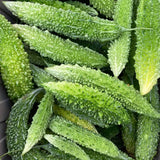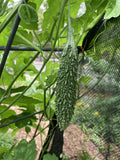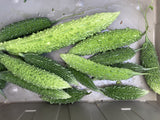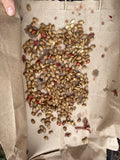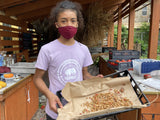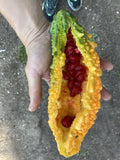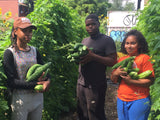Futo Spindle Bitter Melon
Momordica charantia
Heirloom bitter melon with long climbing vines, small yellow flowers, and 7-8" bumpy fruits. While bitter melon is most often associated with subtropical and tropical Asian foodways, they are also well-loved in parts of Africa (where this species originates) and the Caribbean. While this type is often attributed to Japan, it was first introduced from China to now occupied Okinawa where it is more widely eaten and where it is known as Goya and Nigauri. These seeds were grown for our catalog by two awesome community farms in Brooklyn who grow these delicious and healthy vegetables for their Caribbean neighbors.
Notes from Jeremy Teperman of East New York Farms!:
I would also add that customers use both the fruits as well as the leaves, which are made into a tea. Jamaicans call the vines/leaves "cerasee" or "cerasee bush", although technically that is a different variety of bitter melon grown specifically for the leaves, and produces smaller fruits. Both the leaves and fruits are thought to aid in mitigating high blood pressure and diabetes.
Fruits should be harvested when full sized but still dark green and firm. As the fruit matures the bumps swell up more, the flesh softens and turns first a lighter green and finally a brilliant orange, and finally the fully ripe fruits will split open at the bottom and release the seeds which are covered in a sweet red pulp. For ease of harvesting seeds, harvest the fruits when they are very soft and orange but before they split open. For seed processing, open fruits and scoop the seeds with their pulp into a container, fill with water and let ferment for a couple of days. Then decant the seeds onto a screen or colander and agitate them with water to release all the red pulp, which should have loosened off the seeds.
We've found that the seeds germinate best after being soaked overnight and sown on trays on heat mats or in a warm environment. However, once sprouted they grow fine in an unheated greenhouse and will be stronger and less leggy than if allowed to grow indoors until transplant. Transplant after last frost 1-2ft apart under a VERY sturdy trellis- this plant is a vigorous grower and will produce many branching vines which get quite heavy with fruits and leaves. Vines grow slowly at first but eventually very vigorously, and should produce fruit by mid summer in the NYC area, with fruit production tapering off through the early fall. The plants will survive through later into the fall although some of the vines will start dying back. This variety seems to be pretty resistant to pests and diseases.
Days to maturity: 60-70
Seeds per pack: 10
Germination rate: 80% on 01/24/2024
Planting / harvesting notes
Direct sow outdoors after the last threat of frost has passed, or get a head start and sow indoors a couple weeks beforehand. For better germination, soak seeds overnight in warm water before planting. The plant will use as much trellising as you give it! These vines grow up to 12’ and thrive in the heat and sun.
Seed keeping notes
Seeds are ripe when the fruits turn a fiery orange-red. If you wait too long to harvest, they will pop open and drop their seeds, which are covered in a sweet, red gel. Remove the seed coat and dry the seeds in a well ventilated place away from direct sunlight. We have found that smooshing the seeds in a cloth bag will help remove the seed coat more efficiently.
Photo credit: East New York Farms!









